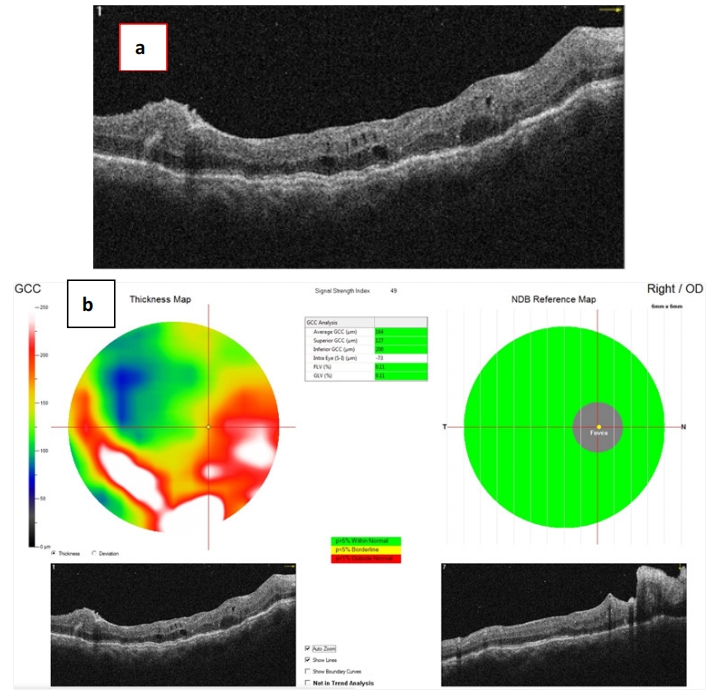1、Joswig H, Epprecht L, Valmaggia C, et al. Terson syndrome in
aneurysmal subarachnoid hemorrhage—its relation to intracranial
pressure, admission factors, and clinical outcome[ J]. Acta Neurochir,
2016, 158(6): 1027-1036.Joswig H, Epprecht L, Valmaggia C, et al. Terson syndrome in
aneurysmal subarachnoid hemorrhage—its relation to intracranial
pressure, admission factors, and clinical outcome[ J]. Acta Neurochir,
2016, 158(6): 1027-1036.
2、Fountas K, Kapsalaki E, Lee GP, et al. Terson hemorrhage in patients
suffering aneurysmal subarachnoid hemorrhage: predisposing factors
and prognostic significance[J]. J Neurosurg, 2008, 109(3): 439-444.Fountas K, Kapsalaki E, Lee GP, et al. Terson hemorrhage in patients
suffering aneurysmal subarachnoid hemorrhage: predisposing factors
and prognostic significance[J]. J Neurosurg, 2008, 109(3): 439-444.
3、Terson A . De l’hémorrhagie dans le corps vitre au cours de
l’hémorrhagie cerebrale[ J]. Clin Ophthalmol, 1900, 6: 309-312.Terson A . De l’hémorrhagie dans le corps vitre au cours de
l’hémorrhagie cerebrale[ J]. Clin Ophthalmol, 1900, 6: 309-312.
4、Obuchowska I, Kochanowicz J, Mariak Z, et al. Early changes in the
visual system connected with brain's aneurysm rupture[ J]. Klinika
Oczna, 2010, 112(4-6): 120-123.Obuchowska I, Kochanowicz J, Mariak Z, et al. Early changes in the
visual system connected with brain's aneurysm rupture[ J]. Klinika
Oczna, 2010, 112(4-6): 120-123.
5、Schultz PN, Sobol WM, Weingeist TA. Long-term visual outcome in
terson syndrome[ J]. Ophthalmology, 1991, 98(12): 1814-1819.Schultz PN, Sobol WM, Weingeist TA. Long-term visual outcome in
terson syndrome[ J]. Ophthalmology, 1991, 98(12): 1814-1819.
6、Weingeist TA, Goldman EJ, Folk JC, et al. Terson's syndrome[ J].
Ophthalmology, 1986, 93(11): 1435-1442.Weingeist TA, Goldman EJ, Folk JC, et al. Terson's syndrome[ J].
Ophthalmology, 1986, 93(11): 1435-1442.
7、Liu X, Yang L, Cai W, et al. Clinical features and visual prognostic
indicators after vitrectomy for Terson syndrome[ J]. Eye, 2020, 34(4):
650-656.Liu X, Yang L, Cai W, et al. Clinical features and visual prognostic
indicators after vitrectomy for Terson syndrome[ J]. Eye, 2020, 34(4):
650-656.
8、Gnanaraj L, Tyagi AK, Cottrell DG, et al. Referral delay and ocular
surgical outcome in terson syndrome[ J]. Retina, 2000, 20(4): 374-377.Gnanaraj L, Tyagi AK, Cottrell DG, et al. Referral delay and ocular
surgical outcome in terson syndrome[ J]. Retina, 2000, 20(4): 374-377.
9、秦波, 赵铁英, 成洪波, 等. Terson综合症的玻璃体切割手术治
疗 [ J]. 国际眼科杂志, 2005, 5(1):31-33.
Qin B, Zhao TY, Cheng HB, et al. Vitrectomy for Terson syndrome[ J].
Int J Ophthalmol, 2005, 5(1): 31-33.秦波, 赵铁英, 成洪波, 等. Terson综合症的玻璃体切割手术治
疗 [ J]. 国际眼科杂志, 2005, 5(1):31-33.
Qin B, Zhao TY, Cheng HB, et al. Vitrectomy for Terson syndrome[ J].
Int J Ophthalmol, 2005, 5(1): 31-33.
10、Shaw HE, Landers MB. Vitreous hemorrhage after intracranial
hemorrhage[ J]. Am J Ophthalmol, 1975, 80(2): 207-213.Shaw HE, Landers MB. Vitreous hemorrhage after intracranial
hemorrhage[ J]. Am J Ophthalmol, 1975, 80(2): 207-213.
11、张承芬. 眼底病学[M]. 2版. 北京: 人民卫生出版社, 2010: 462-
463.
Zhang CF. Diseases of ocular fundus[M]. 2nd ed. Beijing: People's
Medical Publishing House, 2010: 462-463.张承芬. 眼底病学[M]. 2版. 北京: 人民卫生出版社, 2010: 462-
463.
Zhang CF. Diseases of ocular fundus[M]. 2nd ed. Beijing: People's
Medical Publishing House, 2010: 462-463.
12、Sakamoto M, Nakamura K, Shibata M, et al. Magnetic resonance
imaging findings of Terson's syndrome suggesting a possible vitreous
hemorrhage mechanism[ J]. Jpn J Ophthalmol, 2010, 54(2): 135-139.Sakamoto M, Nakamura K, Shibata M, et al. Magnetic resonance
imaging findings of Terson's syndrome suggesting a possible vitreous
hemorrhage mechanism[ J]. Jpn J Ophthalmol, 2010, 54(2): 135-139.
13、Chiao D, Ksendzovsky A, Buell T, et al. Intraventricular migration of
silicone oil: a mimic of traumatic and neoplastic pathology[ J]. J Clin
Neurosci, 2015, 22(7): 1205-1207.Chiao D, Ksendzovsky A, Buell T, et al. Intraventricular migration of
silicone oil: a mimic of traumatic and neoplastic pathology[ J]. J Clin
Neurosci, 2015, 22(7): 1205-1207.
14、Ren Y, Wu Y, Guo G. Terson syndrome secondary to subarachnoid
hemorrhage: a case report[ J]. World Neurosurg, 2019, 124: 25-28.Ren Y, Wu Y, Guo G. Terson syndrome secondary to subarachnoid
hemorrhage: a case report[ J]. World Neurosurg, 2019, 124: 25-28.
15、Ju C, Li S, Huang C, et al. Clinical observations and considerations
in the treatment of Terson syndrome using 23G vitrectomy[ J]. Int
Ophthalmol, 2020, 40(9): 2185-2190.Ju C, Li S, Huang C, et al. Clinical observations and considerations
in the treatment of Terson syndrome using 23G vitrectomy[ J]. Int
Ophthalmol, 2020, 40(9): 2185-2190.
16、Sugimoto M, Kondo M. Lecithin-bound iodine prevents disruption
of tight junctions of retinal pigment epithelial cells under hypoxic
stress[ J]. J Ophthalmol, 2016, 2016: 9292346.Sugimoto M, Kondo M. Lecithin-bound iodine prevents disruption
of tight junctions of retinal pigment epithelial cells under hypoxic
stress[ J]. J Ophthalmol, 2016, 2016: 9292346.
17、Ali Riza Cenk C, Ebru KA, Emrah AU, et al. Hyperbaric oxygen for the
treatment of the rare combination of central retinal vein occlusion and
cilioretinal artery occlusion[ J]. Diving Hyperb Med, 2016, 46(1): 50-
53.Ali Riza Cenk C, Ebru KA, Emrah AU, et al. Hyperbaric oxygen for the
treatment of the rare combination of central retinal vein occlusion and
cilioretinal artery occlusion[ J]. Diving Hyperb Med, 2016, 46(1): 50-
53.
18、Ogawa T, Kitaoka T, Dake Y, et al . Terson syndrome [J] .
Ophthalmology, 2001, 108(9): 1654-1656.Ogawa T, Kitaoka T, Dake Y, et al . Terson syndrome [J] .
Ophthalmology, 2001, 108(9): 1654-1656.
19、Czorlich P, Skevas C, Knospe V, et al. Terson's sy ndrome–
Pathophysiologic considerations of an underestimated concomitant
disease in aneurysmal subarachnoid hemorrhage[ J]. J Clin Neurosci,
2016, 33: 182-186.Czorlich P, Skevas C, Knospe V, et al. Terson's sy ndrome–
Pathophysiologic considerations of an underestimated concomitant
disease in aneurysmal subarachnoid hemorrhage[ J]. J Clin Neurosci,
2016, 33: 182-186.



